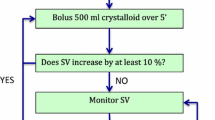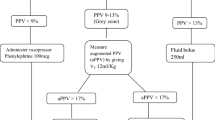Abstract
Purpose
Transesophageal Doppler (TED)-guided intraoperative fluid therapy has shown to noninvasively optimize intravascular volume and reduce postoperative morbidity. The aim of this study was to compare the effects of Doppler-guided intraoperative fluid administration and central venous pressure (CVP)-guided fluid therapy on renal allograft outcome and postoperative complications.
Methods
A prospective nonrandomized active controlled study was conducted on end-stage renal disease patients scheduled for living donor renal transplant surgery. 110 patients received intraoperative fluid guided by corrected flow time (FTc) and variation in stroke volume values obtained by continuous TED monitoring. Data of 104 patients in whom intraoperative fluid administration was guided by CVP values were retrospectively obtained for a control.
Results
The amount of intraoperative fluid given in the study group (12.20 ± 4.24 ml/kg/h) was significantly lower than in the controls (22.21 ± 4.67 ml/kg/h). The amount of colloid used was also significantly less and fewer recipients were seen to require colloid (69 vs 85 %). The mean arterial pressures were comparable throughout. CVP reached was 7.18 ± 3.17 mmHg in the study group. It was significantly higher in the controls (13.42 ± 3.12 mmHg). The postoperative graft function and rate of dysfunction were comparable. Side-effects like postoperative dyspnoea (4.8 vs 0 %) and tissue edema (9.6 vs 2.7 %) were higher in the controls.
Conclusions
FTc-guided intraoperative fluid therapy achieved the same rate of immediate graft function as CVP–guided fluid therapy but used a significantly less amount of fluid. The incidence of postoperative complications related to fluid overload was also reduced. The use of TED may replace invasive central line insertions in the future.



Similar content being viewed by others
References
Martinez BS, Gasanova I, Adesanya AO. Anesthesia for kidney transplantation: a review. J Anesth Clin Res. 2013;4:270–6.
Humar A, Kerr SR, Ramcharan T, Gillingham KJ, Matas AJ. Peri-operative cardiac morbidity in kidney transplant recipients: incidence and risk factors. Clin Transplant. 2001;15(3):154–8.
Yee J, Parasuraman R, Narins RG. Selective review of key preoperative renal electrolyte disturbances in chronic renal failure patients. Chest. 1999;115(5):149s–57s.
Carlier M, Squifflet JP, Pirson Y, Gribomont B, Alexandre GP. Maximal hydration during anesthesia increases pulmonary arterial pressures and improves early function of human renal transplants. Transplantation. 1982;34(4):201–4.
Bacchi G, Buscaroli A, Fusari M, Neri L, Cappuccilli ML, Carretta E, Stefoni S. The influence of intraoperative central venous pressure on delayed graft function in renal transplantation: a single-center experience. Transplant Proc. 2010;42:3387–91.
Toth M, Reti V, Gondos T. Effect of recipients’ peri-operative parameters on the outcome of kidney transplantation. Clin Transplant. 1998;12:511–7.
Abass SM, Hill AG. Systematic review of the literature for the use of oesophageal Doppler monitor for fluid replacement in major abdominal surgery. Anaesthesia. 2008;63:44–51.
Schober P, Loer SA, Schwarte LA. Perioperative hemodynamic monitoring with transesophageal Doppler technology. Anesth Analg. 2009;109:340–53.
Roth R, Chowdhury F, Frost E. Extubation: making the unpredictable safer. Anaesthesiology News Guide Airway management. 2012. pp. 69–74. http://anaesthesiologynews.com/download/Extubation_ANGAM12_WM.pdf. Accessed 12 July 2015.
Othman MM, Ismael AZ, Hammouda GE. the impact of timing of maximal crystalloid hydration on early graft function during kidney transplantation. Anesth Analg. 2010;110(5):1440–6.
Tan JC, Busque S, Scandling J. Clinical management. In: Maarteen WT, Chertow GM, editors. Brenner and rector’s the kidney. 9th ed. Elsevier: Saunders; 2012. p. 2523.
Solez K, Colvin RB, Racusen LC, Haas M, Sis B, Mengel M. Banff 07 classification of renal allograft pathology: updates and future directions. Am J Transplant. 2008;8:753–60.
Ferris RL, Kittur DS, Wilasrusmee C, Shah G, Krause E, Ratner L. Early haemodynamic changes after renal transplantation: determinants of low central venous pressure in the recipients and correlation with acute renal dysfunction. Med Sci Monit. 2003;9(2):61–6.
Othman MM. Perioperative hydration policy, understanding the complexities of kidney transplantation. In: Jorge O editors. 2011. ISBN: 978-953-307-819-9.
O’Malley CMN, Frumento RJ, Bennett-Guerrero E. Intravenous fluid therapy in renal transplant recipients: results of a US survey. Transplant Proc. 2002;34:3142–5.
O’Malley CMN, Frumento RJ, Hardy MA, Benvenisty AI, Brentjens TE, Mercer JS, Bennett-Guerrero E. A randomized, double-blind comparison of lactated Ringer’s solution and 0.9 % NaCl during renal transplantation. Anesth Analg. 2005;100:1518–24.
Hadimioglu N, Saadawy I, Saglam T, Ertug Z, Dinckan A. The effects of different crystalloid solutions on acid-base balance and early kidney function after kidney transplantation. Anesth Analg. 2008;107:264–9.
Khajavi MR, Etezadi F, Moharari RS, Imani F, Meysami AP, Khashayar P, Najafi A. Effects of normal saline vs. Lactated Ringer’s during renal transplantation. Ren Fail. 2008;30:535–9.
Schnuelle P, van der Woude FJ. Perioperative fluid management in renal transplantation: a narrative review of the literature. Transplant Int. 2006;19:947–59.
Wakeling HG, McFall MR, Jenkins CS, Woods WG, Miles WF, Barclay GR, Fleming SC. Intraoperative oesophageal Doppler guided fluid management shortens postoperative hospital stay after major bowel surgery. Br J Anaesth. 2005;95:634–42.
Singer M, Bennett ED. Non-invasive optimisation of left ventricular filling by esophageal Doppler. Crit Care Med. 1991;9:1132–7.
Laupland KB, Bands CJ. Utility of esophageal Doppler as a minimally invasive hemodynamic monitor: a review. Can J Anaesth. 2002;49:393–401.
Campos L, Parada B, Furriel F, Castelo D, Moreira P, Mota A. Do intraoperative hemodynamic factors of the recipient influence renal graft function? Transplant Proc. 2012;44(6):1800–3.
De Gasperi A, Narcisi S, Mazza E, Bettinelli L, Pavani M, Perrone L, Grugni C, Corti A. Perioperative fluid management in kidney transplantation: is volume overload still mandatory for graft function? Transplant Proc. 2006;38(3):807–9.
Author information
Authors and Affiliations
Corresponding author
Ethics declarations
Conflict of interest
None.
About this article
Cite this article
Srivastava, D., Sahu, S., Chandra, A. et al. Effect of intraoperative transesophageal Doppler-guided fluid therapy versus central venous pressure-guided fluid therapy on renal allograft outcome in patients undergoing living donor renal transplant surgery: a comparative study . J Anesth 29, 842–849 (2015). https://doi.org/10.1007/s00540-015-2046-4
Received:
Accepted:
Published:
Issue Date:
DOI: https://doi.org/10.1007/s00540-015-2046-4




